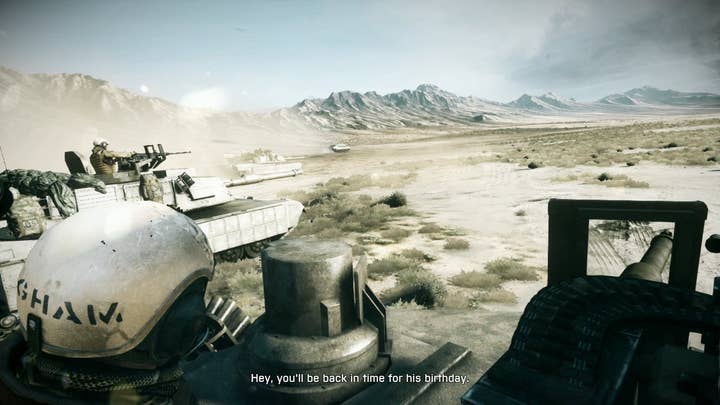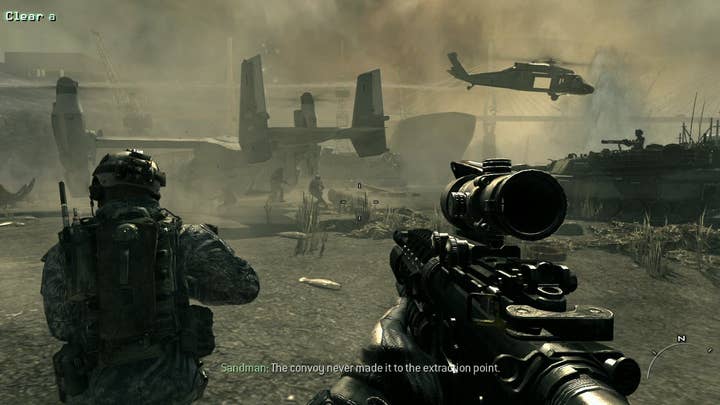Tech Focus: Modern Warfare 3 vs. Battlefield 3
Digital Foundry on the technical merits of the year's biggest shooters.
However, while the perception is that Battlefield has a lot of catching up to do to challenge the Call of Duty franchise, it's clear that Infinity Ward and Sledgehammer have taken some inspiration from DICE on both macro and micro levels. The "HDR" audio developed for Battlefield: Bad Company 2, which dynamically mixes and adjusts audio according to context gets its own take in MW3, making it easily the most audibly satisfying Call of Duty to date. We also see some small, neat ideas developed by DICE reduxed for MW3 - for example, masking loud noises (in this case an explosion) using thunder with a cue provided by lighting is a direct homage to the excellent sniper focused section from the Bad Company 2 single-player campaign.
The overall impression you get from playing both single-player campaigns back to back is that the advantages DICE has in terms of its technology have not been transformed into gameplay that makes the most of them - even the showpiece destruction technology seems to be limited and toned down compared to what it is capable of in multiplayer mode. On the flipside, the Modern Warfare 3 achievement is remarkable: the campaign is fast and indeed furious, beautifully paced and teeming with interesting scenarios and variety. What is may lack in technical advancement is more than made up for by the action and the gameplay.
The Modern Warfare 3 development teams have also managed to retain the series' trademark 60FPS gameplay: while it is somewhat short of the sustained, zero compromise frame-rate promised by Infinity Ward "Creative Strategist" Rob Bowling in his tweets over the summer, the game is clearly far more responsive and arcade-like than its DICE equivalent.
As the next-gen draws closer, DICE and EA are well-positioned to fully capitalise on the immense potential of its beautiful new Frostbite 2 technology
From a single-player perspective at least, the difference between Battlefield 3 and the new Modern Warfare is remarkable - while the comparison of new tech vs. an established, reinvigorated engine is intriguing, it's the surrounding elements that really make the Activision game what it is: excellent production values, a story that makes sense, a non-stop breakneck pace, tons of variety, some great ideas (zero G gunplay in a plane plummeting to the ground - yes!) and a sense of polish that is definitely missing from DICE's game.

The achievement is all the more remarkable bearing in mind the respective positions of the BF3 and MW3 developers as they started work on their respective projects - DICE has been making these games consistently for many years now but Battlefield 3 is rife with issues, offering up sub-par single-player and co-op modes, while Activision's disparate development teams - cobbled together in the wake of Infinity Ward's implosion - has managed to hand in an ultra-slick, assured game that truly delivers on all levels.
It may well be that the production of the Frostbite 2 engine - carried out to a certain extent in tandem with Battlefield 3 - may have caused issues as the studio finds its feet with its fresh new tech. However, going forward, the advantage DICE and EA have is that the second game using the engine will almost certainly be a significant improvement over its first. There's also an undeniable sense that DICE is future-proofing itself against the transitional period we have coming up in the next couple of years.
We can get a taste of the challenges that face Activision going forward by checking out the PC version of Modern Warfare 3. Suffice to say it's a world apart from the experience offered up by Battlefield 3: shorn of its frame-rate advantage on PC, the game simply doesn't compare from a visual perspective: textures are of a remarkably lower resolution, effects work is far more basic and console-like, and the lighting model lacks much of the fidelity found in DICE's game. It's a game of extremes - the scenes that look spectacular on console look even more remarkable on PC, while the plainer, more basic elements simply don't stand up to scrutiny when scaled up to 1080p or higher resolutions. The unavoidable conclusion is that MW3's console focus is so tight that freed from the sub-HD console confines (both 360 and PS3 run at 1024x600 native res), the assets simply don't really work very well.

What we're seeing here with these two games is a clear difference in priorities: DICE has scaled down its PC tech to work on current generation consoles, while Modern Warfare scales up for PC, with only very limited success. Bearing in mind that the vast majority of its sales will be on console, it's doubtful that Activision will be too upset about the shortcomings of the PC game, but it's difficult not to believe that Battlefield will be offering a far more robust challenge to the current market leader when next-gen consoles appear in 2013. Frostbite 2 is simply incredible today: by the time new hardware is available, it's going to be even better.
In the here and now, Activision can congratulate themselves on the creation of the quintessential console shooter - a superb value package that delivers in all three of its major modes: campaign, co-op and multiplayer. For its part, Battlefield 3 isn't the same consummate all-rounder, but it's still one hell of a good online shooter, and different enough from Call of Duty to enjoy phenomenal success in its own right - and going forward, as the next-gen draws closer, DICE and EA are well-positioned to fully capitalise on the immense potential of that beautiful Frostbite 2 technology...








